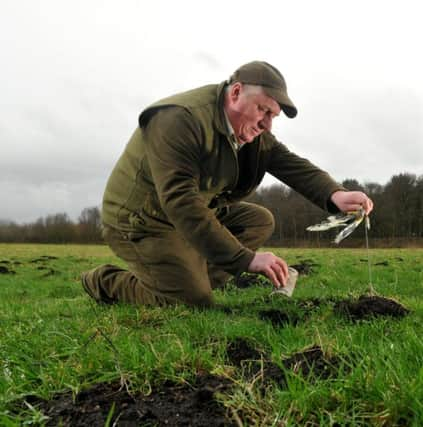Meet the man that all moles should fear


Being outside, with a multitude of North West skylines in front of you and the sweet sounds of birds tweeting can be an idyllic way to spend your time.
For Craig Parkinson it is all in a day’s work, as he is a mole-catcher.
Advertisement
Hide AdAdvertisement
Hide AdWhilst it may not appear to be a common-known job, the 52-year-old has many regular clients and is fully booked for the next few months.
And his work takes him all over the region. It’s not countryside locations like the Pennines or Lake District either: Wigan borough is one of those places that he has visited on more than one occasion to rid landowners of these pesky varmints.
And as well as being called up by private individuals and organisations, he is also officially contracted by Natural England and the Environment Agency to get rid of moles on their land too.
They may be small and cute to some but these subterranean creatures can not only ruin the beauty of a landscape, but also cause flooding and a danger to cattle by their excavations.
Advertisement
Hide AdAdvertisement
Hide AdWith a love of animals, and after being taught how to do it by a game keeper, it seemed a natural career choice for Craig, who lives in Tarleton.
He says: “I have been catching moles since I was 16.
“When I left school I was an assistant game keeper at Hornby Castle in Lancaster and the gardener showed me how to catch moles.
“I got made redundant and started doing it myself. I have had other jobs as well as I had a young family to support.
“I had a milk round and I farmed sheep at our farm in Tarleton.
Advertisement
Hide AdAdvertisement
Hide Ad“Around 10 years ago I fully set up again as a mole catcher and set up a website.
“I have always had an interest in animals and I like being outdoors. It is a great office! “I have views of the lovely countryside. On a sunny day you can see the Pennines for miles and you can hear the birds tweeting.”
The father of two insists that catching moles is necessary to maintain the farming industry and keep the local environment safe.
He adds: “I have to catch them to keep numbers down. I don’t go killing every one in site.
Advertisement
Hide AdAdvertisement
Hide Ad“It is about helping farmers in their livelihood. It is about maintaining farmland to ensure the welfare of livestock as mole soil in silage makes in unpalatable for cattle.
“Mole damage can cause significant risk to the environment.
“For example, I have been working in Croston and if there is too much mole activity, it can weaken structures and cause a breach to the flood banks.
“If the flood banks burst, it would cause an awful lot of damage.
“I work across the North West, covering the Fylde, Ribble Valley, South Ribble, Chorley, Preston and Wigan.
Advertisement
Hide AdAdvertisement
Hide Ad“I was recently at Winstanley College, removing moles from land there.
“I also catch moles from private gardens.
“People don’t want their gardens destroyed by moles.”
Craig, who has two grandchildren, plus another due in April, uses specially designed traps from the 19th century.
He reveals: “I have always used traps which were designed in the late 1800s.
“They have a tunnel or duffus. There is no better method and they are the most humane, as the traps kill them instantly.
“I then bury the moles.
Advertisement
Hide AdAdvertisement
Hide Ad“I treat them with respect. They are fantastic little creatures but they cause too much damage to farmland.
“When people hear what I do and the reasons for it, they are accepting as they realise it is necessary.”
Moles, like other wild mammals, are protected from cruel treatment but may be killed as pests using humane methods.
The Wild Mammals (Protection) Act 1996 outlaws beating and asphyxiation, but accepted methods include the use of traps, ferrets and gas.
Advertisement
Hide AdAdvertisement
Hide AdMoles usually feed on insect pests, grubs, and soil organisms, including beneficial ones like earthworms.
In addition to their surface feeding tunnels, moles also dig deeper tunnels, called runways, in which they make their nests and travel throughout their territory.
The soil excavated from these runways are deposited on the surface in the form of mounds of loose soil called mole hills.
Their tunnels are usually at least 10ins underground, unless they are scanning the surface in search of a mate.
Surface tunnels or ridges also indicate mole activity.
Advertisement
Hide AdAdvertisement
Hide AdMoles are small mammals which have evolved to adapt to a subterranean lifestyle.
They have cylindrical bodies, velvety fur, very small, inconspicuous ears and eyes, reduced hindlimbs and short, powerful forelimbs with large paws adapted for digging.